EC number 6.3.1.2 ExPASy NiceZyme view HUGO 4341 | CAS number 9023-70-5 OMIM 138290 | |
 | ||
Protein amino acid metabolism part 5 of 8 glutamine synthetase gs
Glutamine synthetase (GS) (EC 6.3.1.2) is an enzyme that plays an essential role in the metabolism of nitrogen by catalyzing the condensation of glutamate and ammonia to form glutamine:
Contents
- Protein amino acid metabolism part 5 of 8 glutamine synthetase gs
- Glutamine synthetase regulation
- Structure
- Mechanism
- Biological Function
- Classes
- Regulation Inhibition
- References
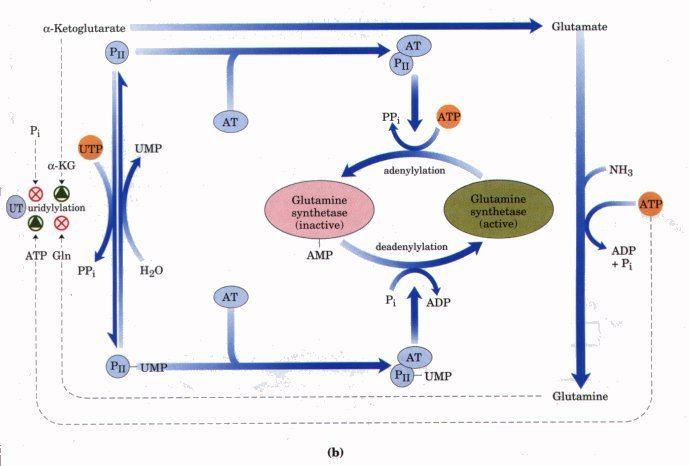
Glutamate + ATP + NH3 → glutamine + ADP + phosphate
Glutamine Synthetase uses ammonia produced by nitrate reduction, amino acid degradation, and photorespiration. The amide group of glutamate is a Nitrogen source for the synthesis of glutamine pathway metabolites.
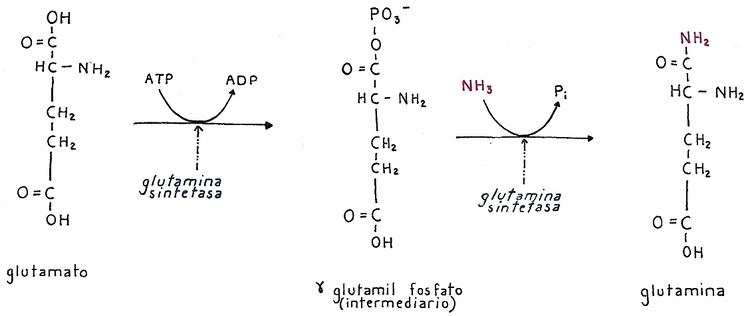
Other reactions may take place via GS. Competition between ammonium ion and water, their binding affinities, and the concentration of ammonium ion, influences glutamine synthesis and glutamine hydrolysis. Glutamine is formed if an ammonium ion attacks the acyl-phosphate intermediate, while glutamate is remade if water attacks the intermediate. Ammonium ion binds more strongly than water to GS due to electrostatic forces between a cation and a negatively charged pocket. Another possible reaction is upon NH2OH binding to GS, rather than NH4+, yields γ-glutamylhydroxamate.
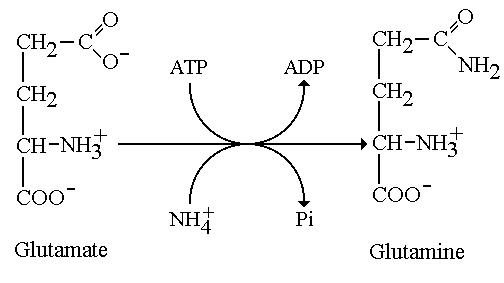
Glutamine synthetase regulation
Structure

Glutamine Synthetase can be composed of 8, 10, or 12 identical subunits separated into two face-to-face rings. Bacterial GS are dodecamers with 12 active sites between each monomer. Each active site creates a ‘tunnel’ which is the site of three distinct substrate binding sites: nucleotide, ammonium ion, and amino acid. ATP binds to the top of the bifunnel that opens to the external surface of GS. Glutamate binds at the bottom of the active site. The middle of the bifunnel contains two sites in which divalent cations bind (Mn+2 or Mg+2). One cation binding site is involved in phosphoryl transfer of ATP to glutamate, while the second stabilizes active GS and helps with the binding of glutamate.
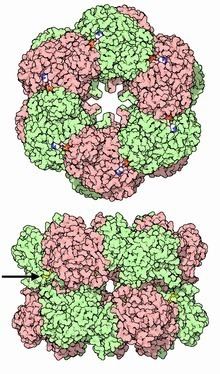
Hydrogen bonding and hydrophobic interactions hold the two rings of GS together. Each subunit possesses a C-terminus and an N-terminus in its sequence. The C-terminus (helical thong) stabilizes the GS structure by inserting into the hydrophobic region of the subunit across in the other ring. The N-terminus is exposed to the solvent. In addition, the central channel is formed via six four-stranded β-sheets composed of anti-parallel loops from the twelve subunits.
Mechanism
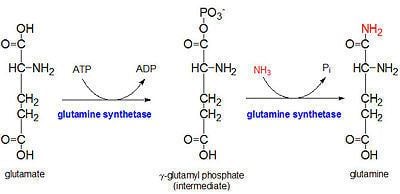
GS catalyzes the ATP-dependent condensation of glutamate with ammonia to yield glutamine. The hydrolysis of ATP drives the first step of a two-part, concerted mechanism. ATP phosphorylates glutamate to form ADP and an acyl-phosphate intermediate, γ-glutamyl phosphate, which reacts with ammonia, forming glutamine and inorganic phosphate. ADP and Pi do not dissociate until ammonia binds and glutamine is released.
ATP binds first to the top of the active site near a cation binding site, while glutamate binds near the second cation binding site at the bottom of the active site. The presence of ADP causes a conformational shift in GS that stabilizes the γ-glutamyl phosphate moiety. Ammonium binds strongly to GS only if the acyl-phosphate intermediate is present. Ammonium, rather than ammonia, binds to GS because the binding site is polar and exposed to solvent. In the second step, deprotonation of ammonium allows ammonia to attack the intermediate from its nearby site to form glutamine. Phosphate leaves through the top of the active site, while glutamine leave through the bottom (between two rings).Goodsell, DS (June 2002). "Glutamine Synthetase". RCSB Protein Data Bank. Retrieved 8 May 2010.
Biological Function
GS is present predominantly in the brain, kidneys, and liver. GS in the brain participates in the metabolic regulation of glutamate, the detoxification of brain ammonia, the assimilation of ammonia, recyclization of neurotransmitters, and termination of neurotransmitter signals. GS, in the brain, is found primarily in astrocytes. Astrocytes protect neurons against excitotoxicity by taking up excess ammonia and glutamate. In hyperammonemic environments (high levels of ammonia), astroglial swelling occurs. Different perspectives have approached the problem of astroglial swelling. One study shows that morphological changes occur that increase GS expression in glutamatergic areas or other adaptations that alleviates high levels of glutamate and ammonia. Another perspective is that astrocyte swelling is due to glutamine accumulation. To prevent increased levels of cortical glutamate and cortical water content, a study has been conducted to prevent GS activity in rats by the use of MSO.
Classes
There seem to be three different classes of GS:
Plants have two or more isozymes of GSII, one of the isozymes is translocated into the chloroplast. Another form is cytosolic. The cytosolic GS gene translation is regulated by its 5' untranslated region (UTR), while its 3' UTR plays role in transcript turnover.
While the three classes of GS's are clearly structurally related, the sequence similarities are not so extensive.
Regulation & Inhibition
Reversible Covalent Modification. A tyrosine residue in each subunit in GS can be modified by adenylylation. Adenylyl transferase catalyzes the adenylylation and phosphorolysis reactions. Adenyl transferase activity is influenced by two regulatory proteins: PA and PD. PA reduces GS activity by attaching an AMP unit to GS. Adenylyl transferase and PD removes the AMP unit. PA and PD may be interconverted via uridylyl transferase. Adenylylated GS is less active than unadenylated GS. In the majority of gram-negative bacteria, GS can be modified by adenylylation (some cyanobacteria and green algae or exceptions).
Inhibition of GS has largely focused on amino site ligands. Other inhibitors are the result of glutamine metabolism: tryptophan, histidine, carbamoyl phosphate, glucosamine-6-phosphate, cytidine triphosphate (CTP), and adenosine monophosphate (AMP). Other inhibitors/regulators are glycine and alanine. Alanine, glycine, and serine bind to the glutamate substrate site. GDP, AMP, ADP bind to the ATP site. L-serine, L-alanine, and glycine bind to the site for L-glutamate in unadenylated GS. The four amino acids bind to the site by their common atoms, “the main chain” of amino acids. Glutamate is another product of glutamine metabolism; however, glutamate is a substrate for GS inhibiting it to act as a regulator to GS.2 Each inhibitor can reduce the activity of the enzyme; once all final glutamine metabolites are bound to GS, the activity of GS is almost completely inhibited. Many inhibitory input signals allows for fine tuning of GS by reflecting nitrogen levels in the organism.
Feedback regulation distinguishes the difference between two eukaryotic types of GS: brain and non-brain tissues. Non-brain GS responds to end-product feedback inhibition, while brain GS does not. High concentrations of glutamine-dependent metabolites should inhibit GS activity, while low concentrations should activate GS activity.
Inhibitors:
